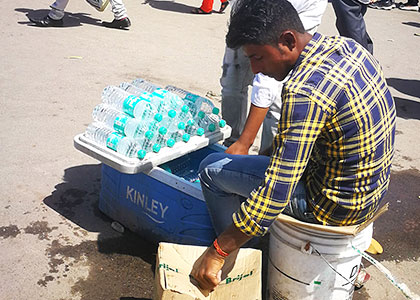Drinking Water in India: Health-wise Tips for Travelers
India is a vast country with diverse landmarks and heritage sites. Many awestruck tourists come here to explore this dynamic country filled with sight, sounds, and flavors. But sometimes the Indian climate might become overwhelming for the overseas visitors. Coupled with questions regarding hygiene, many tourists end up with bad cases of stomach flu, diarrhea, or dysentery.
The availability of pure drinking water in India is always a big question for international travelers. Pollution, heat, and lack of clean drinking water are always on their minds. However, contrary to popular opinion, in India, one can find pure drinking water. With some precautions and presence of mind, most visitors can avoid most water-borne diseases.
Here are some tips that can help tourists in spending a great time during their Indian sojourn, without worrying about diseases.
1. Only Drink Bottled Water

Drink Bottled and Sealed Water
|
2. Filtering the Water
Although, bottled drinking water is readily available in India while trekking through the Himalayan outback availability of bottled water might dropdown. In these cases, carrying a portable water purification system, iodine tablets, or boiling the water before drinking could be done. These methods are useful as emergency alternatives.
PS: Many environmentally conscious tourists avoid buying bottled drinking water as plastic is a major contributor to pollution in the world.
3. Do Not Fret about Water – Concentrate on Other Things As Well
Locating pure drinking water in India is important, but tourists must also concentrate on things. Since the Indian climate is different from the European or the American climatic conditions, many tourists end up being sick due to a lack of immunity. According to the Center for Disease Control (CDC), before coming to India visitors must get themselves vaccinated against common diseases.The recommended list of vaccination includes:
• Hepatitis A and B
• Typhoid• Cholera
• Yellow Fever
• Japanese Encephalitis
• Rabies
• Meningitis
• Polio
• Measles
• Mumps And Rubella (Mmr)
• Tdap (Tetanus, Diphtheria, And Pertussis)
• Chickenpox
• Shingles
• Pneumonia
• Influenza
Other alternatives Tender coconut water is a good alternative to bottled water and is very refreshing on a hot Indian summer. Coconut water is filled with necessary electrolytes and other nutrients and above all its vegan. Apart from tender coconut, one can go for local packages drinks and shakes that come with a sealed straw. Tourists who are feeling nostalgic can sip Coco Cola or Pepsi (widely available) as well.
4. Indian Chai
Indian Chai, or Chai Latte, is made from boiling water at high temperature – making it completely safe for drinking. It is probably India’s favorite drink, and most discussions are incomplete without it. Made with tea, lots of milk, sugar, and several other Ayurvedic condiments – the drink is very refreshing. Also, due to its widespread availability, tourists can always depend on the Indian tea for quenching their thirst.
5. Stay Hydrated
Indian weather can take a massive toll on the health of the international visitor. Therefore, drinking water in India becomes essential. Ideally, tourists should drink at least two liters of water daily to stay hydrated. Tourists engaging in activities like hiking or trekking should intake more water.
6. Brushing with Bottled Water
Indian tap water might be contaminated with pollutants and micro-organisms and could lead to potential water-borne diseases. It is recommended to brush the teeth with bottled drinking water in India.
Special note on ice
It is recommended to avoid ice cubes. Most of the commercial ice, available at stores and restaurants, are made from contaminated water and may harbor harmful microbes.
Additionally, it is recommended to avoid drinking cold water. Chilled water can upset the digestive system of overseas tourists, and therefore it is better avoided.
Methods for Purifying Water
As discussed above, many tourists prefer filtering their water instead of going for bottled water. Here are some of the ways tourists can purify their drinking water:
All-in-one filtration and purification bottles are preferred by several tourists, as these are easy to clean and maintain. Some of the portable filtrations bottles contain activated carbon capsules and perforated membranes to filter water. Also, it reduces the foul odor and improves the taste. There are several options available in the market, and one can choose according to their preference.
The lightweight UV filters destroy the DNA of the microbes making the water safe for consumption. Mostly these devices, require electricity, are capable of killing almost 99% of microbes in a short time. On the downside, these filters do not separate larger sediments.
These devices are smaller in size but effective in purifying the water. The device creates a disinfectant by passing electricity through brine water (mixing salt to water). This disinfectant purifies close to 25 liters of water making it suitable for storing large amounts of water.
Chlorine and iodine tablets have been used by several tourists to purify their water. However, these chemicals are difficult to use and can leave an after taste in water. Another popular alternative is Sodium Dichloroisocyanurate (NaDCC) – an affordable and easy to use alternative to these chemicals.
Important Highlights
Beverages that is safe for drinking:
• Bottled water• Tender coconut
• Canned noncarbonated drinks
• Canned carbonated beverages including soft drinks or beer
• Coffee or tea
Things that should be avoided:
• Tap water and ice• Salads and cut fruits available bought from street vendors
• Spicy sauces in open containers
• Fruits peeled by others
Finding drinking water in India is a big challenge for most tourists, but a bit pre-planning and some precautions can help the tourists in enjoying a memorable holiday in the country.

